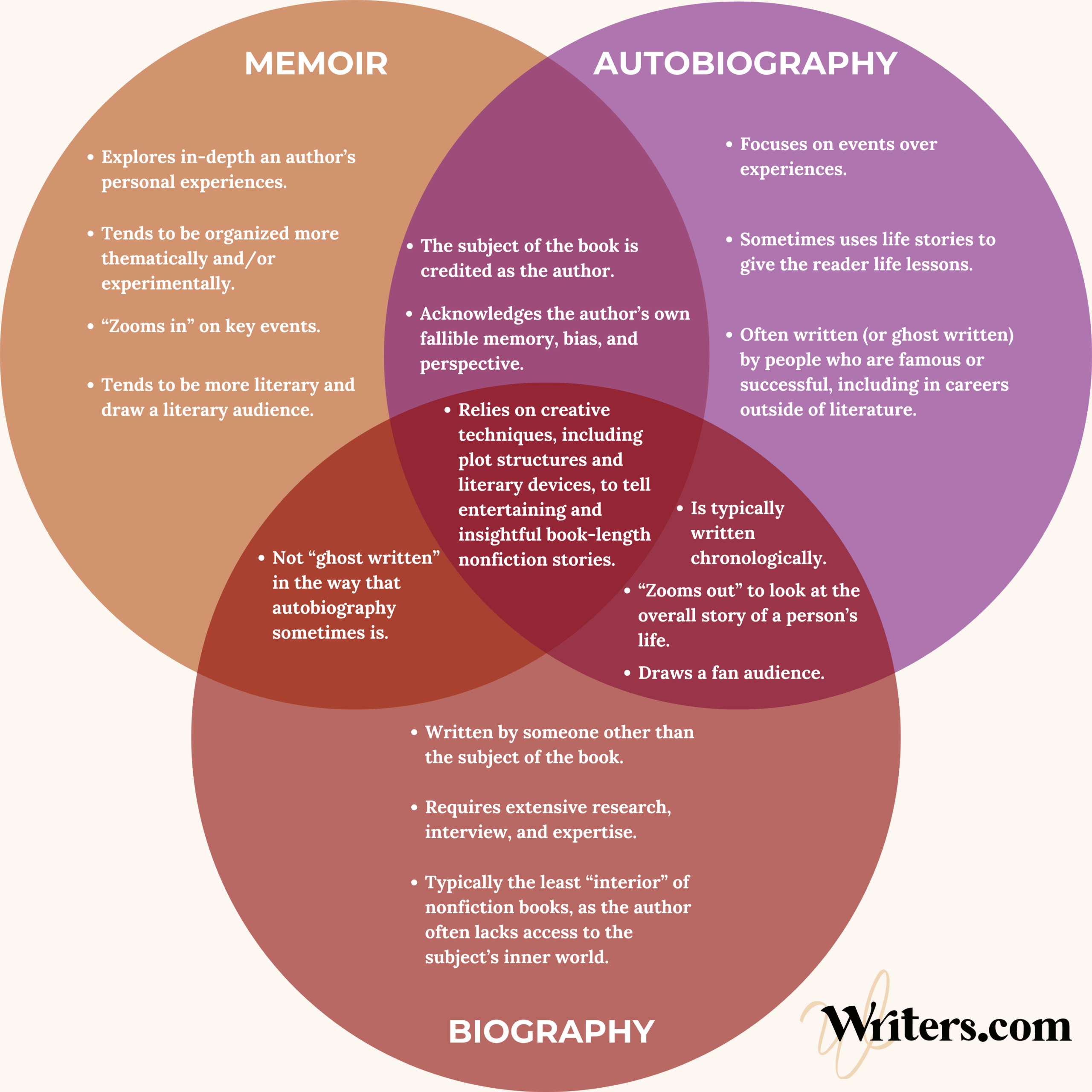What is the difference between a memoir vs autobiography vs biography? These three categories of nonfiction describe different approaches to telling your life’s story. But while these books all sit within the realm of creative nonfiction, their approaches vary greatly.
If you want your story told to the world, keep reading to learn about the craft techniques and differing approaches to memoir vs autobiography vs biography.
Memoir Vs Autobiography Vs Biography: Contents
Memoir vs Autobiography vs Biography: Definitions
Memoirs, biographies, and autobiographies are all book-length nonfiction projects that aim to tell the stories of your lives. They differ, however, in their scopes, approaches, and goals. Let’s first define each category of nonfiction book:
Memoir
A memoir is a book-length work of nonfiction that privileges the writer’s personal experiences. Memoirs intend to showcase, reflect upon, and uncover the author’s own experience.
Memoirs showcase, reflect upon, and uncover the author’s own experience.
Memoirs tend to be more personal and less objective: a good memoirist acknowledges their own biases and predispositions, but does not necessarily shy away from them. Memoirs also tend to be “zoomed in”—they explore key events in the author’s life story in detail, emphasizing themes and connected events rather than the author’s entire life story.
Learn more about memoir here:
https://writers.com/how-to-write-a-memoir
Some 21st century memoir examples include:
- My Salinger Year by Joanna Rakoff
- In the Dream House by Carmen Maria Machado
- The Year of Magical Thinking by Joan Didion
- A Man of Two Faces by Viet Thanh Nguyen
Article continues below…
Nonfiction Writing Courses We Think You'll Love
We've hand-picked these courses to help you flourish as a writer.

Writing the Memoir-in-Essays: 8-Week Workshop
Discover the rich hybrid form of the memoir-in-essays, and write full essays as you move toward a completed manuscript.
Find Out More
Write Your Memoir in 16 Weeks: Bring Your Story to Life
Write your memoir in 4 months. Discover the heart of your story, and submit up to 3,000 words each week...
Find Out More
Lapses, Flashes, and Fragments: How to Write Through Challenging Memories
Shape your difficult life experiences into a compelling memoir. Discover how to find and share your story's pivotal moments with...
Find Out MoreOr click below to view all courses.
See CoursesArticle continues…
Autobiography
Where memoirs are about the author’s personal understanding of life events, autobiographies tend to emphasize the events themselves.
This is not to say that autobiographies are more objective; only, perhaps, that they’re a little less interior. Autobiographies tend to give the “bigger picture” of the author’s life story. The focus is maybe a little heavier on plot, a little lighter on character, to borrow from the craft of fiction.
Autobiographies tend to give the “bigger picture” of the author’s life story.
As such, autobiographies “zoom out” to explore the broader scope of an author’s life. Often, autobiographies are written by people who have already led successful careers, including careers outside of literature. Sometimes, autobiographies are “ghost written”, meaning the “author” pays someone else to do the writing but puts their own name on the byline.
Some examples of autobiography include:
- What Have I Done? by Ben Elton
- Hope in Action by Sanna Marin
- Normally Weird and Weirdly Normal by Robin Ince
- I Know Why the Caged Bird Sings by Maya Angelou
Autobiographical Fiction
You may have heard of autobiographical fiction before. Autobiographical fiction is fiction largely based on the author’s own life: certain details and plot points may change to enhance the story, and the names of the characters differ, but the author’s life informs every aspect of the work.
Autobiographical fiction is another approach to telling your life’s story. Despite its name, works of autobiographical fiction can be more “zoomed in” like a memoir. Learn more here:
Biography
The key difference between a biography and an autobiography is that, where an author tells their own story in an autobiography, the author is telling someone else’s story in a biography.
Where an author tells their own story in an autobiography, the author is telling someone else’s story in a biography.
In other words, if I was trying to write my own life’s story, I would write an autobiography; if I wanted to write the life story of J. Edgar Hoover, it would be a biography. A biography is always written by someone other than the subject of the book.
As a result, biographies tend to be the least interior of nonfiction books. Many biographers interview their subjects, and even the families and social circles of those subjects. Nonetheless, biographers are exterior observers, beholden to what they see and what they are told about the topics of their books.
Biographies, of course, are not exempt from bias. Both the biographer’s slant and the slant of the biographer’s subject both influence the direction of the story.
Some examples of biography include:
- Margaret Fuller: A New American Life by Megan Marshall
- American Prometheus: The Triumph and Tragedy of J. Robert Oppenheimer by Kai Bird and Martin J. Sherwin
- Eden’s Outcasts: The Story of Louisa May Alcott and Her Father by John Matteson
- Harriet Beecher Stowe – A Life by Joan D. Hedrick
Memoir vs Autobiography vs Biography: A Look at Craft
If memoirs, autobiographies, and biographies differ in the ways described, what does the craft of each of them look like? Let’s zoom in on some of the ways an author’s approach changes in each of these modes of nonfiction writing.
Memoir vs Autobiography vs Biography: Interiority
By interiority, we mean the writing’s ability to explore, excavate, and expand upon deeply private and personal experiences. Interiority includes a person’s thoughts, feelings, and inner world.
- Memoir: Tends to be the most interior, as it focuses closely on key thematic events in an author’s life, and the author is able to represent themselves authentically and deeply.
- Autobiography: Can contain a lot of interiority, though the book’s focus tends to be on more events over a greater span of time, which sometimes results in less interior representation.
- Biography: Tends to be the least interior, as the biographer must find and develop interiority through interviews and reportage. Some biographies, still, are highly interior and capable of unpacking the subject’s inner world.
Memoir vs Autobiography vs Biography: Scope and Style
How does a writer approach the craft of a memoir vs autobiography vs biography? What are common differences in their styles?
- Memoir: Focus on personal experience and personal interpretations of lived experiences. As such, memoirs often have a narrower scope and a more personal style. They are more likely to use fiction-writing techniques, such as scene-setting and dialogue.
- Autobiography: Focus more on the formative events in the author’s life, most commonly across their entire life or else with regard to an important aspect of it (like a certain career or relationship). Put a different way, autobiographies are interested in the facts of one’s life, whereas memoirs are interested in the truth of one’s life.
- Biography: Similar in scope and style to autobiography, but with the difference that someone other than the subject is writing the story, and so the biographer’s own style impacts the storytelling.
Memoir vs Autobiography vs Biography: Time Span and Structure
The way nonfiction book writers think about the structure and span of time in their books is as follows:
- Memoir: Tends to focus on a smaller span of time in which details and experiences can be heightened and thoroughly explored. Memoirs also tend to experiment more with time and structure: they are not necessarily told linearly or chronologically. Some memoirs are braided; others are written in essays.
- Autobiography: Tends to incorporate many different aspects of the author’s life, potentially from childhood to the author’s present age. Otherwise, an autobiography might span the topic of the book’s interest, like the start-to-finish of the author’s career.
- Biography: Similar to autobiography, biographies typically look at the whole of the author’s life, from childhood to the present or the end.
Memoir vs Autobiography vs Biography: Philosophy
What do memoirists and (auto)biographers intend to accomplish in their books?
- Memoir: A memoir is a project of memory. While memoirists often conduct research and incorporate it into the stories they tell, memoirs themselves privilege the author’s memory—acknowledging its fallibilities and biases, yes, but also its emotional truths. Memoirists often question the accuracy of their own memories in the work itself.
- Autobiography: Where memoir is interested in memory, autobiography is typically more interested in verifiable fact. Autobiographers use memory as a doorway into telling their stories, but then focus on facts, reportage, and research to construct the story itself. Autobiographers often see their stories as legacies, where memoirs tend to be projects and experimentations of story and memory. Some autobiographies are also written with an eye towards life advice to the reader.
- Biography: Biographies are written by someone other than the subject, so they are often the most fact-based and objective. The subjects of biographies are typically famous or well-regarded people. Other than this, biographers and autobiographers often tell their stories with similar approaches and structures, though it depends on whether the biographer’s subject is living or dead.
Memoir vs Autobiography vs Biography: Audience
Who are the intended readers of memoirs, autobiographies, and biographies?
- Memoir: Memoirists often tie their stories to specific themes and ideas, and so connect to readers who are similarly thinking about those ideas. A memoir about a relationship, for example, might be very different from a memoir about politics and protest. Of course, many readers of memoir will gravitate to both topics, as memoirs plumb the depths of our shared humanity. People are also drawn to memoir for having, on average, more artistic and literary writing.
- Autobiography: Readers of autobiographies are often interested in the authors themselves, and so are drawn to the book because they want to hear the author tell the story of their life. Some autobiographers are already writers, but many more come from other fields: business, politics, cinema, music, fashion, etc.
- Biography: Similar to autobiography, biography readers are often primarily interested in the subject of the book. Because biographies might be written about dead people, biographies also draw readers of history and historical subjects.
Memoir vs Autobiography vs Biography: Venn Diagram
The below Venn diagram illustrates the key differences between memoir vs autobiography vs biography.
Other Forms of Creative Nonfiction
If you’re interested in exploring other forms of creative nonfiction—or even writing a memoir or autobiography composed of other nonfiction forms—check out our resources below.
More Tips on Writing Creative Nonfiction
Here are some more tips for telling your story authentically.
- What is Creative Nonfiction?
- Fiction Vs Nonfiction
- Marrying Literature and Life
- How to Write a Book About Your Life
Write Your Nonfiction Book at Writers.com
Ready to write your nonfiction book? Whether you write memoir, autobiography, or biography, write it in one of our upcoming online creative nonfiction writing courses.



I’ve been writing, on and off, my memoirgraphy. Not sure if that’s a thing. It’s certainly drawing a red underline..
Hi Joy,
Terms like memoir and autobiography are useful categories, but nothing more. If books like “dreamoirs” and “biomythographies” exist (and they do!), “memoirgraphy” gets to exist, too. 🙂
Sean